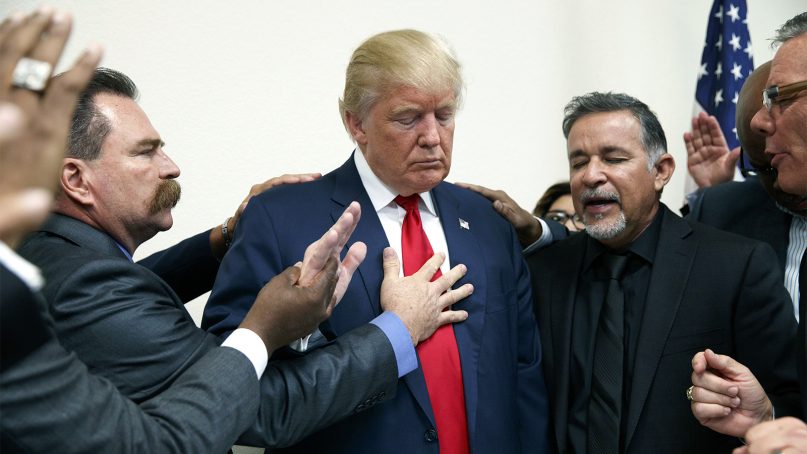Not since the religious right burst onto the national political scene four decades ago has an American president done more to cultivate its good will than Donald Trump. Let us count the ways.
- He assembled a Who’s Who of evangelical activists as his religious advisors.
- He pledged to do away with the Johnson Amendment barring religious organizations (and other non-profits) from engaging in partisan politics.
- He said he would restrict Muslims from entering the United States and issued executive orders doing just that.
- He has attached himself closely to Israel’s right-wing government and moved the U.S. embassy to Jerusalem.
- He has rolled back the Affordable Care Act’s mandate to cover contraceptive services for women.
- He promised to pick Supreme Court justices who would do away with Roe v. Wade, and has chosen two nominees who many think will do that.
- He has reversed the Obama Administration’s requirement that those who object to receiving social services from faith-based providers be given secular alternatives.
- He has signed on to a “religious liberty” agenda making it easier to obtain exemptions from laws protecting LGBT people from discrimination.
- He has embraced Russian president Vladimir Putin, whose hostility to Islam and opposition to gay rights have endeared him to leading social conservatives.
There’s no question that these positions have locked in Trump’s support among white evangelicals, who make up about a quarter of the electorate. Eighty percent voted for him, and his favorability rating with them remains in that neighborhood.
What about the rest of the GOP’s religious base? Will it be on board for the coming midterm elections, which are shaping up as a referendum on Trump and his policies?
Orthodox Jews no doubt will be. In stark contrast to their Conservative and Reform co-religionists, they vote Republican, and Trump’s pro-Israel posture has only made them more enthusiastic about doing so. Indeed, at 71 percent, the Orthodox are Trump’s most loyal religious supporters after evangelicals.
Mormons are a trickier case. A year after his inauguration, 61 percent gave Trump a favorable rating. This was the same percentage who voted for him—well below their usual level of support for Republican presidential candidates. Trump’s decidedly un-Mormon personal style rubs them the wrong way, and there is serious opposition to his immigration policy in a church with longstanding and increasingly strong ties to Latin America. Whether the mixed feelings will rub off on Republicans running for lesser offices in November is an open question.
The American Catholic community, increasingly Latino, is more opposed to Trump’s immigration policies, to such an extent that this has weakened the hierarchy’s support for the anti-abortion party. White Catholics, who chose Trump over Clinton 56 percent to 37 percent, are now evenly divided in viewing him favorably. As for white mainline Protestants, who also voted for him by a significant margin, they appear to be less enamored as well. There’s no question that the religious left, though much smaller than the religious right, has been roused to action by Trump policies in a way not seen since the Vietnam war.
A critical quantitative measure of the role of religion in our electoral politics is the behavior of voters who, regardless of affiliation, say they attend religious services at least once a week. In most elections from 2000 through 2014, these voters chose Republican presidential and congressional candidates over Democrats by margins of roughly 20 percentage points. In 2016 this “God Gap” narrowed to 14 points. Why?
From 2012 to 2016, the percentage of women voting for the Republican candidate dropped by three points and the percentage of men voting for the Democrat dropped by four. Because women tend to be more religious than men, the likely explanation for the smaller God Gap is that Trump lost ground among frequent-attending women while gaining ground among less frequent-attending men. For on issues where there’s a gender divide—like gun control, climate change, and immigration—the GOP position pushes women away and draws men in.
According to a Quinnipiac poll taken at the end of last year, women support stricter gun laws 69 percent to 26 percent, as compared to men, who are divided 47 percent to 47 percent. In March, Pew reported that 54 percent of women were “concerned believers” in global warming, as opposed to just 42 percent of men. Last month, a Harvard/Harris poll showed women considerably more likely than men to blame the Trump Administration for separating children and parents at the border, 64-36 versus 57-43.
Come November, the growing salience of these issues may well widen the overall partisan gender gap and thus shrink the God Gap further.
Finally, any assessment of the role of religion in the midterms must take into account the growing portion of the U.S. population that has opted out of religion: those who answer “none” when asked “what is your religion, if any,” and those who say the never attend religious services. In 2016, the “Nones” voted for Clinton over Trump 67 percent to 25 percent and the “Nevers,” 62-30. Call the latter the “Godless Gap.”
In 2006, when the Democrats recaptured both houses of Congress from the Republicans, the Nevers were 15 percent of the voting population; in 2016, they were 22 percent. In 2006, self-described weekly attenders were 45 percent of the voting population; in 2016, they were 33 percent. By these numbers, there’s a blue wave coming.






